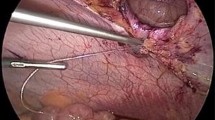Abstract
Background
The da Vinci robotic laparoscopic incisional hernia repair with intracorporeal closure of the fascial defect and circumferential suturing of the mesh may offer an alternative to current fascial closure and transabdominal sutures and tackers.
Methods
From 2009 to 2011, a retrospective review of 13 patients with a mean age of 51 years, median body mass index (BMI) of 31.53 kg/m2, and small and medium-sized ventral hernias (mean fascial defect 37.39 cm2) were treated with the da Vinci robot system using intracorporeal primary closure of the fascial defect with a running O-absorbable suture followed by underlay mesh fixation using a continuous running, circumferential, nonabsorbable suture. This study aimed to assess the technical feasibility of the procedure. In addition, the operating time and specific morbidity of postoperative pain, and long-term recurrence were recorded.
Results
The mean operating time was 131 min. There were no conversions to open or standard laparoscopic techniques. There were no postoperative deaths. The overall morbidity rate was 13%. One patient remained in hospital for pain control, and another experienced urinary retention that required a Foley catheter. The mean hospital stay was 2.4 days. During a median follow-up period of 23 months, one of the patients experienced a recurrent hernia. None experienced chronic suture site pain or discomfort.
Conclusions
This is a retrospective series review of robot-assisted ventral hernia repair using intracorporeal primary closure followed by continuous running, circumferential fixation. The findings show that this technique is feasible and may not be associated with chronic postoperative pain. Further evaluation is needed, and long-term data are lacking to assess the benefit to the patient, but this series can be the basis for future studies.


Similar content being viewed by others
References
Mudge M, Hughes LE (1985) Incisional hernia: a 10-year prospective study of incidence and attitudes. Br J Surg 72:70–71
Ballantyne GH, Hourmont K, Wasielewski A (2003) Telerobotic laparoscopic repair of incisional ventral hernias using intraperitoneal prosthetic mesh. JSLS 7:7–14
LeBlanc KA, Heniford BT, Voeller GR (2006) Innovations in ventral hernia repair. Contemp Surg 2006;April:1–8
Van der Linden FT, Van Vroonhoven TJ (1988) Long-term results after surgical correction of incisional hernia. Neth J Surg 40:127–129
Stoppa RE (1989) The treatment of complicated groin and incisional hernia. World J Surg 13:545–554
Laber GE, Garb JL, Alexander AI et al (1998) Long-term complications associated with prosthetic repair of ventral hernias. Arch Surg 133:378–382
White TJ, Santos MC, Thompson JS (1998) Factors affecting wound complications in repair of ventral hernias. Am Surg 64:276–280
Heniford BT, Park A, Ramshaw et al (2003) Laparoscopic repair of ventral hernias: nine years’ experience with 850 consecutive hernias. Ann Surg 238:391–400
Perrone JM, Soper NJ, Eagon JC et al (2005) Perioperative outcomes and complications of laparoscopic ventral hernia repair. Surgery 138:708–715
Carbajo MA, Martin de Olmo JC, Blanco JI et al (1999) Laparoscopic treatment vs open surgery in the solution of major incisional and abdominal wall hernias with mesh. Surg Endosc 13:250–252
Franklin ME, Dorman JP, Glass JL et al (1998) Laparoscopic ventral and incisional hernia repair. Surg Laparosc Endosc 8:294–299
Heniford BT, Ramshaw BJ (2000) Laparoscopic ventral hernia repair: a report of 100 consecutive cases. Surg Endosc 14:419–423
Heniford BT, Park A, Ramshaw BJ et al (2000) Laparoscopic ventral and incisional hernia repair in 407 patients. J Am Coll Surg 190:645–650
Sanders LM, Flint LM, Ferrara JJ (1999) Initial experience with laparoscopic repair of incisional hernias. Am J Surg 177:227–231
Earle D, Seymour N, Fellinger E et al (2006) Laparoscopic versus open incisional hernia repair: a single-institution analysis of hospital resource utilization for 884 consecutive cases. Surg Endosc 20:71–75
Harrell AG, Novitsky YW, Peindl RD et al (2006) Prospective evaluation of adhesion formation and shrinkage of intraabdominal prosthetics in a rabbit model. Am Surg 72:808–813
McKinlay RD, Park A (2004) Laparoscopic ventral incisional hernia repair: a more effective alternative to conventional repair of recurrent incisional hernia. J Gastrointest Surg 8:670–674
Berger D, Bientzle M, Muller A (2002) Postoperative complications after laparoscopic incisional hernia repair. Surg Endosc 16:1720–1723
Bansal VK, Misra MC, Kumar S et al (2011) A prospective randomized study comparing suture mesh fixation versus tacker mesh fixation for laparoscopic repair of incisional and ventral hernias. Surg Endosc 25:1431–1438
Dubay DA, Wang X, Kirk S et al (2004) Fascial fibroblast kinetic activity is increased during abdominal wall repair compared to dermal fibroblasts. Wound Repair Regen 12:539–545
Giulianotti PC, Coratti A, Angelini M et al (2003) Robotics in general surgery: personal experience in a large community hospital. Arch Surg 138:777–784
LeBlanc KA, Booth WV (1993) Laparoscopic repair of incisional abdominal hernias using expanded polytetrafluoroethylene: preliminary findings. Surg Laparosc Endosc 3:39–41
Schluender S, Conrad J, Divino CM et al (2003) Robot-assisted laparoscopic repair of ventral hernia with intracorporeal suturing. Surg Endosc 17:1391–1395
Tayar C, Karoui M, Cherqui D et al (2007) Robot-assisted laparoscopic mesh repair of incisional hernias with exclusive intracorporeal suturing: a pilot study. Surg Endosc 21:1786–1789
LeBlanc KA (2001) The critical technical aspects of laparoscopic repair of ventral and incisional hernias. Am Surg 67:809–812
Conflict of interest
Drs. Erik Wilson and Brad Snyder have agreements with Intuitive Surgical for contract fees when giving national and international robotic lectures or proctoring other surgeons for credentialing of robotic privileges. In addition, the minimally invasive fellowship at the University of Texas is partially funded by Intuitive Surgical, Ethicon Endosurgery, and Gore. This work is independent of any of these industries, and no endowments were provided for this manuscript.
Author information
Authors and Affiliations
Corresponding author
Rights and permissions
About this article
Cite this article
Allison, N., Tieu, K., Snyder, B. et al. Technical Feasibility of Robot-Assisted Ventral Hernia Repair. World J Surg 36, 447–452 (2012). https://doi.org/10.1007/s00268-011-1389-8
Published:
Issue Date:
DOI: https://doi.org/10.1007/s00268-011-1389-8




